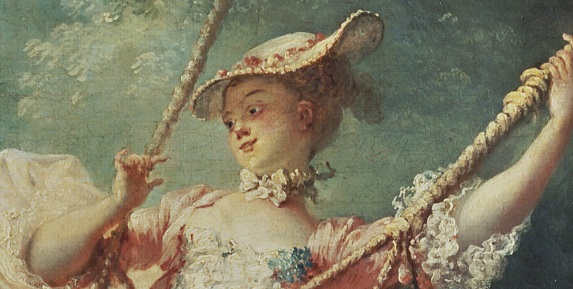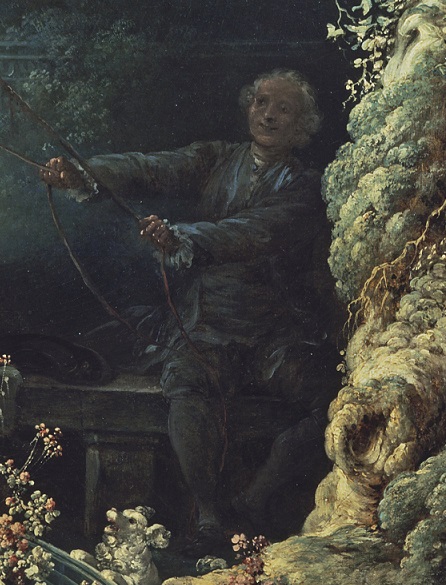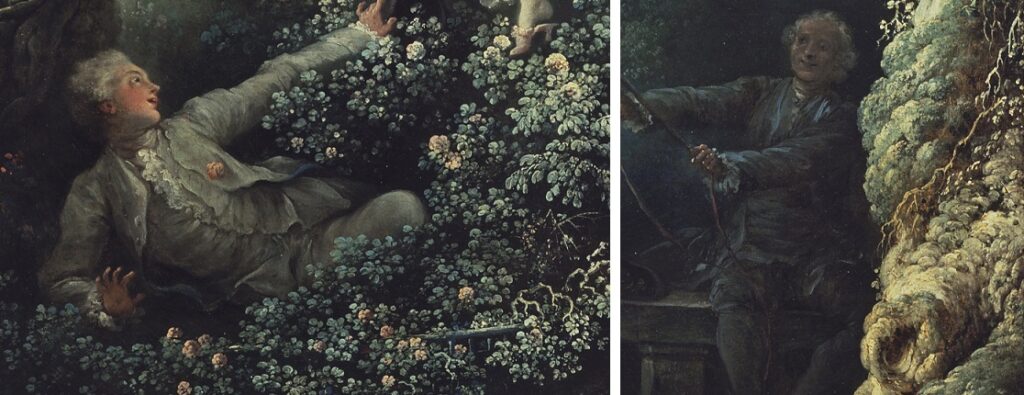French painting “Les Hasards heureux de l’escarpolette” of Jean-Honoré Fragonard (1767-1769). By izaline Broudic
I’m going to talk about art history, focusing especially on the painting “Les Hasards heureux de l’escarpolette”. I’ll discuss its meaning and the different symbols we can observe in it.
Firstly, in the painting, we can see the light falling in the center of the artwork, where a young aristocrat is shown on an escarpolette (the old version of a modern swing). Her pink and white dress contrasts with the other colors of the painting, so our eyes first focus on her.
It looks as if the young aristocrat seems to fly into the sky. With a grace and playful look, she throws her shoe with her left leg toward her affair partner who is hiding in the bushes.

By doing this, she reveals her ankle – a very sensual and shocking thing in the eighteenth century, when it was not proper for women to show their legs. The “happy accident” in the scene is that the baron, young woman’s lover (in the bottom left) is hiding in the perfect look of her without being seen. Of course, this “happy accident” is not really one, the young woman doesn’t look surprised to see him there. She seems to enjoy teasing him, throwing her shoe and letting him see her foot, her legs and maybe more…
The baron looks both shocked and excited by what he sees. He seems to have lost his balance and fallen among the flowers, amazed by the beauty and sensuality of his lover.
The young woman is not as innocent as her old husband thinks. Behind her childish look, she clearly knows how to attract her lover with her gestures and glances. So, the virtue of innocence (shown by the white color of her dress) is broken by the two young lovers.
Hanging in the air, the unfaithful wife knows that, at this moment, she is out of reach for her lover (who cannot risk being seen) and she seems to laugh about it. Between them, it is a sensual and dangerous game, played right under the nose of the deceived husband.
The cheated husband is in the background of the painting. Sitting on a bench, he seems to join in his young wife’s fun as he pushes the swing. However, the deceived husband thinks his wife is just enjoying the childlike pleasure of swinging in the air. He smiles while pushing the swing and looks at his wife kindly.

Maybe he hears her mischievous laugh and thinks he is the reason she is happy, while it is clear that she is mocking him. From his place, the husband cannot see the hidden lover who is enjoying the scene, while he only sees his wife from behind. He never suspects that his charming wife is playing him and that this game in the clearing exists only to entertain her lover.
The poor husband seems to be the only one who does not see the game between the two lovers. In fact, in many parts of the painting, there are little angels whose expressions show that they understand the lover’s trick. On the left side of the painting, a putto (cupidon, a symbol of love) clearly knows about the secret affair between the baron and his mistress, because he is holding his finger to his lips. His gesture “draws attention to the young couple and seems to ask us to keep quiet, but he is also looking at two small cupids, the first looks away, while the second stares at the young woman in shock, meeting the putto’s gaze, who seems to tell him to be silent.
The little angels are not the only ones who notice the trick the two lovers are playing on the old aristocrat. On the right side of the painting, a small dog barks at the young woman and also at the putto, showing its teeth. Through this dog which probably belongs to the cheated husband, the artist, Fragonard seems to want to show the loyalty between the dog and his master, which is clearly stronger than the loyalty between the wife and her husband.

In Fragonard painting, the vegetation also plays a role and is not random. The scene takes place in an isolated clearing, hidden from view. It is an intimate place where the old aristocrat believes he is alone with his wife. The plants around the husband (in the background) are withered, while the plants around the lover are green and full of flowers. In this way, the dying plants and the cheated husband represent the past, while the flowers in the girl’s plan and the lover symbolize a bright future, which seems already planned for the young woman and her lover.

Fragonard’s painting shows the triumph of secret love in an erotic setting. The swing takes her from her husband to her lover, as long as this “innocent” game lasts. We see (imagine) a love triangle with these three characters. The really interesting thing is that when you see the painting for the first time you can’t imagine all this meaning. Then after you know the history you can see clearly all the details of the paint and to take another look at this artwork.
So now I want to ask you a question. What was your feeling when you first saw the painting?


Great job!!!